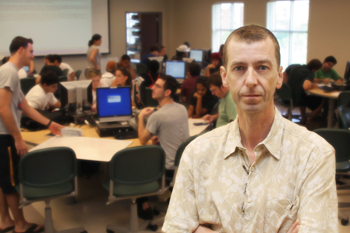FSU re-tools physics instruction with new classroom, technology
If you step into one physics classroom on Florida State University's campus, you may not recognize it as the same course you took in high school or college. Making use of state-of-the-art technology, Associate Professor Simon Capstick is helping his students get a more hands-on, collaborative educational experience — and actually learn more in the process.

Capstick's "General Physics A Studio" course, which focuses on the physics of motion, is unique in that it is taught in a classroom that was specifically built with just such an innovative approach in mind. Located in FSU's new Classroom Building, the classroom enables students to work in small teams, utilize computers to arrive at answers to scientific problems, and easily share their results with the rest of the class.
"This is certainly a departure from the way physics has been taught for decades," Capstick said. "But what we're finding is that this sort of technology enables students to move beyond all of the measurements and calculations that tend to bog down the learning process and really focus on the underlying concepts."
Walking into Room 308 of the Classroom Building, it is immediately apparent that this isn't your grandfather's physics class. There are eight round tables, each with three computers, three dry-erase boards and nine chairs. Large video screens line the front and side walls of the room.
"The idea is to promote a team approach to learning," Capstick said. "In the real world, science is about far more than simply knowing a lot of facts. One has to be able to work collaboratively with others to debate ideas and arrive at an agreed-upon conclusion. One also has to be able to communicate one's findings to others and argue effectively as to why they are correct. This course allows for all of that."
At the beginning of the semester, students are divided into three-person teams and assigned to share a computer and dry-erase board. In discussing physics assignments, they are able to use the computer and then write their calculations on the board. Afterward, groups are called up one by one to the front of the class, where their calculations are projected onto the classroom's video screens. All students in the class then are encouraged to discuss and debate the team's findings.
Team members are switched around several times during the semester to ensure that all students are given an equal opportunity to succeed.
The course also has a weekly lab assignment in the same classroom that utilizes technology in creative ways. Thanks to an Innovative Instruction Grant from FSU's Center for Teaching and Learning (www.learningforlife.fsu.edu/ctl) and additional funding from the College of Arts and Sciences (www.fsu.edu/~fsuas), Capstick has purchased motion-sensing equipment and electronic interfaces that his students can plug in to computers to conduct high-tech experiments — and, according to Capstick, see their results instantly.
"The way that we used to do physics experiments, you might have an object moving and pulling a tape behind it, with a spark timer leaving marks on the tape," Capstick said. "It might be half an hour after you saw the motion before you understood it in terms of velocity, position and acceleration. But with this technology, it's fairly immediate for you to get information about the motion that you're seeing. And part of the reason for these labs being designed the way they are is to make collection and interpretation of the data relatively straightforward."
So, compared to the same lecture about kinetic and potential energy in a traditional physics course, what's the benefit of bouncing a ball and measuring it with an electronic sensor, as students do in Capstick's lab? He says the more modern approach contributes to an increase in how much students learn — at least as measured during the spring 2008 semester, when the technology-supported version of "General Physics with Calculus" was first offered at FSU.
"We gave those students a test before the course started to assess their conceptual understanding," Capstick said. "We then gave them the identical test after the course was finished, and we looked at the percentage of those questions they answered wrong in the pre-test that they answered right in the post-test. What we found is that this number is about twice as high as it is for a traditional lecture/lab course."
Those results have other FSU faculty members considering ways to utilize the technology. Soon, Paul Cottle, FSU's Steve Edwards Professor of Physics, will use it to teach electricity and magnetism in another physics course, "General Physics B Studio."
"While it's important for future scientists and engineers to learn their physics in a hands-on way, it's even more important for future science teachers to do so," Cottle said. "The most important thing for improving the education of science teachers is to improve their understanding of science. And research on learning demonstrates that hands-on learning is the best way to improve understanding of science."